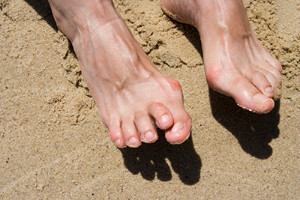What Causes Hammertoe?
Monday, 22 July 2019 00:00 The medical condition that is known as hammertoe occurs when the second and third toes bend downward at the middle joint, causing them to resemble a hammer. This ailment can come from genetic factors, or from wearing shoes that do not have adequate room for the toes to move freely in. Additionally, there may be existing medical conditions which can lead to the development of hammertoes, which can include bunions, or different forms of arthritis. The symptoms that are associated with this condition often include pain in the foot as the toes are stretched downward, and there may be calluses and corns that form on the top of the bent joints. Mild relief may be found when the feet are soaked in warm water, which can make it easier for the toes to stretch by pointing and flexing the ankles. For severe cases of hammertoe, a splint is applied to the affected toes to help keep them as straight as possible. If you have developed this condition, it is strongly suggested that you consult with a podiatrist who can offer treatment options that are correct for you.
The medical condition that is known as hammertoe occurs when the second and third toes bend downward at the middle joint, causing them to resemble a hammer. This ailment can come from genetic factors, or from wearing shoes that do not have adequate room for the toes to move freely in. Additionally, there may be existing medical conditions which can lead to the development of hammertoes, which can include bunions, or different forms of arthritis. The symptoms that are associated with this condition often include pain in the foot as the toes are stretched downward, and there may be calluses and corns that form on the top of the bent joints. Mild relief may be found when the feet are soaked in warm water, which can make it easier for the toes to stretch by pointing and flexing the ankles. For severe cases of hammertoe, a splint is applied to the affected toes to help keep them as straight as possible. If you have developed this condition, it is strongly suggested that you consult with a podiatrist who can offer treatment options that are correct for you.
Hammertoe
Hammertoes can be a painful condition to live with. For more information, contact one of our podiatrists from Advanced Foot & Ankle Associates, PLLC. Our doctors will answer any of your foot- and ankle-related questions.
Hammertoe is a foot deformity that affects the joints of the second, third, fourth, or fifth toes of your feet. It is a painful foot condition in which these toes curl and arch up, which can often lead to pain when wearing footwear.
Symptoms
- Pain in the affected toes
- Development of corns or calluses due to friction
- Inflammation
- Redness
- Contracture of the toes
Causes
Genetics – People who are genetically predisposed to hammertoe are often more susceptible
Arthritis – Because arthritis affects the joints in your toes, further deformities stemming from arthritis can occur
Trauma – Direct trauma to the toes could potentially lead to hammertoe
Ill-fitting shoes – Undue pressure on the front of the toes from ill-fitting shoes can potentially lead to the development of hammertoe
Treatment
Orthotics – Custom made inserts can be used to help relieve pressure placed on the toes and therefore relieve some of the pain associated with it
Medications – Oral medications such as anti-inflammatories or NSAIDs could be used to treat the pain and inflammation hammertoes causes. Injections of corticosteroids are also sometimes used
Surgery – In more severe cases where the hammertoes have become more rigid, foot surgery is a potential option
If you have any questions please contact one of our offices located in Lake Worth and Aledo/Willow Park, TX . We offer the newest diagnostic and treatment technologies for all your foot and ankle needs.
Blog Archives
- April 2025
- March 2025
- February 2025
- January 2025
- December 2024
- November 2024
- October 2024
- September 2024
- August 2024
- July 2024
- June 2024
- May 2024
- April 2024
- March 2024
- February 2024
- January 2024
- December 2023
- November 2023
- October 2023
- September 2023
- August 2023
- July 2023
- June 2023
- May 2023
- April 2023
- March 2023
- February 2023
- January 2023
- December 2022
- November 2022
- October 2022
- September 2022
- August 2022
- July 2022
- June 2022
- May 2022
- April 2022
- March 2022
- February 2022
- January 2022
- December 2021
- November 2021
- October 2021
- September 2021
- August 2021
- July 2021
- June 2021
- May 2021
- April 2021
- March 2021
- February 2021
- January 2021
- December 2020
- November 2020
- October 2020
- September 2020
- August 2020
- July 2020
- June 2020
- May 2020
- April 2020
- March 2020
- February 2020
- January 2020
- December 2019
- November 2019
- October 2019
- September 2019
- August 2019
- July 2019
- June 2019
- May 2019
- April 2019
- March 2019
- February 2019
- January 2019
- December 2018
- November 2018
- October 2018




